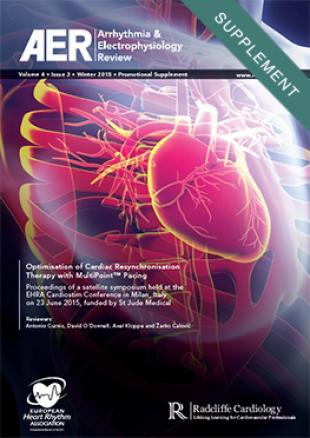Optimisation of Cardiac Resynchronisation Therapy with MultiPoint™ Pacing
Editorial Process
Cardiac resynchronisation therapy (CRT) with biventricular pacing is an effective therapy in patients with advanced heart failure (HF) symptoms (New York Heart Association [NYHA] Class III or IV), an ejection fraction (EF) of 35 % or less and an intraventricular conduction delay (IVCD) of 120 ms or more.1–3 CRT has also been shown to be effective for the prevention of HF in relatively asymptomatic patients with wide QRS.4 However, CRT is underutilised among eligible patients.5 Approximately one-third of patients do not respond to CRT due to various factors, including anatomic difficulties and suboptimal lead placement. To increase the effectiveness of CRT, several experts have hypothesised that pacing at multiple left ventricular (LV) sites may provide more effective resynchronisation. A new approach involving MultiPoint™ pacing with the use of a single quadripolar lead (Quartet™ lead; St Jude Medical, St Paul, MN, US) has recently been proposed. This lead integrates four pacing electrodes, increasing the options in device programming. In order to present an overview of research to date on this technology, a satellite symposium, supported by St Jude Medical and chaired by Dr Antonio Curnis (Brescia, Italy), was held at the European Heart Rhythm Association (EHRA) Europace conference held in Milan, Italy, in June 2015.
Summary and Concluding Remarks
Although technological advances have improved outcomes in patients undergoing biventricular pacing, the optimal placement of pacing leads remains challenging and there is a need to improve response rates to CRT and optimise patient selection. MultiPoint pacing using a quadripolar lead increases the possibility of finding the best pacing site. In clinical studies, use of MultiPoint pacing in HF patients undergoing CRT has been associated with increased haemodynamic and clinical benefits compared with conventional pacing, particularly in patients with the least improvement from biventricular pacing. Use of MultiPoint pacing results in a smaller number of non-responders and further improvements in those that do respond. While data have shown that benefits are sustained at 12 months, there is a need for further long-term studies to investigate the performance and reliability of MultiPoint pacing.
Written By : Katrina Mountfort
Reviewers : Antonio Curnis, David O’Donnel, Axel Kloppe, Žarko Calovic
Citation : Arrhythmia & Electrophysiology Review 2015;4(3 Suppl 1):1-8
DOI : https://doi.org/10.15420/aer.2015.4.3.S1









